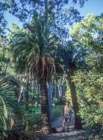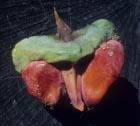
Mature plants in habitat, Carnarvon National Park, Queensland [C.J. Earle, 1996.04.12].

Ripe female cone. Carnarvon National Park, Queensland [C.J. Earle, 1996.04.12].

Megasporophyll with two seeds in their colorful sarcotestae. Carnarvon National Park, Queensland [C.J. Earle, 1996.04.12].

Macrozamia moorei
F. Muell.
Common names
Taxonomic notes
Closely related to M. johnsonii (Jones 1993).
Description
Plant with massive aerial trunk, mostly 2-5 m high and 30-70 cm in diameter. Young leaves bright green. Mature leaves to 150 in a rounded crown, 1.5-3 m by 30-60 cm, dark bluish green, flat in cross section, arching to gracefully curved in profile; petiole 5-10 cm long, swollen and wooly at the base; rhachis not twisted, yellowish, concave above, keeled beneath; leaflets 150-250, moderately crowded, evenly distributed throughout, inserted on the rhachis at about 40°, with stomata on both surfaces, pungent-tipped, ca. 40 of the lowest leaflets progressively reduced to a series of rigid, spine-like processes extending almost to the base of the rachis (spine-free petiole 0-10 cm long); median leaflets 20-40 cm by 5-11 mm, linear, dark bluish green, tapered to a pungent apex, contracted to a white, callous base. Cones markedly dissimilar. Male cones 25-45 cm by 8-10 cm, cylindical, green to brownish, straight or more usually curved, up to 100 on a large plant; sporophylls 2-3 cm by 1.5-2 cm, wedge-shaped, with an erect, apical spine-like appendage 2-20 mm long; peduncle 10-15 cm by 2-3 cm. Female cones 40-90 cm by 12-20 cm, broadly cylindical to barrel-shaped, green, one to eight on each plant; sporophylls 5-10 cm by 4-8 cm, broadly wedge-shaped, expanded near the apex, apical spine-like appendage 2-7 cm long; peduncle 15-25 cm by 3-4 cm, stout. Seeds 4-6 cm by 2.5-3.5 cm, oblong, red to scarlet when ripe (Harden 1990, Jones 1993).
Distribution and Ecology
Australia: NSW & Queensland: N f/Clarence R. valley, including the Carnarvon Range and Emerald, Springsure and Rolleston districts (Harden 1990, Jones 1993). In NSW, occurs "[m]ostly in foothills of ranges in tall wet sclerophyll forest and margins of rainforest, generally on steep slopes" (Harden 1990); in Qld, occurs on low hills in dry sclerophyll forests and woodland, and in the valleys and escarpments of rocky gorges. Summer climate diurnal range 21-35°C, winter 6-23°C; severe frosts common. Annual rainfall 500 mm, with a summer maximum (Jones 1993).
Remarkable Specimens
Normally to 8 m tall and 80 cm dbh (Jones 1993). Plants have grown to 2 m tall from seed in less than 100 years. Plants cone in about 50 years (Jones 1993). Since plants 8 m tall are known, extrapolation would suggest that ages may exceed 400 years.
Ethnobotany
No data, but seeds likely eaten by aboriginals.
Observations
I found this species to be common in and around Carnarvon National Park in Queensland (including the type locality). I have a specimen on my desk, grown from seed.
Remarks
Described in 1881 from material collected on the Nogoa River near Springsure. Species typically occurs in large colonies in scenic rocky areas. Mature cones exceptionally large and numerous. The female cone is the largest in the genus and up to 100 cones have been recorded on a single male plant. In cultivation, it is hardy, preferring full sun but tolerating heavy frost. Transplants readily (Jones 1993).
Citations
See also


